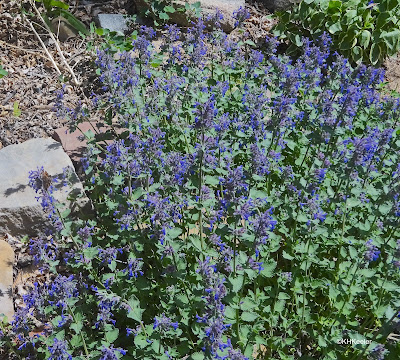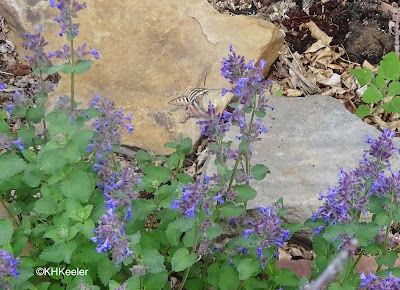Catnip, Nepeta cataria, is famous, the plant that is a cat drug. Its genus Nepeta, however, includes from 251- 350 species, native to the Old World. Several have been introduced into North America as garden plants. This blog is about N. racemosa, called eastern catmint, racemose catmint, and dwarf catnip. You can find it sold as Nepeta mussinii, which was its name, but has been replaced.
 |
| eastern catmint, Nepeta racemosa |
The scientific name Nepeta uses a word the Romans applied to a variety of aromatic plants, especially mints. The species epithet racemosa means that the flowers are in racemes. In a raceme, multiple flowers are each on their own, short stalk which comes from a longer, shared flower stalk.
 |
| big patch of catmint |
My yard came with eastern catmint and I have since figured out its name. When I look at regional garden books, they highly recommend catmints, but note that eastern catmint "reseeds readily" and "has a tendency to self sow."
Oh yes! Garden book understatement! Eastern catmint was energetically spreading all over my yard. I got REALLY tired of weeding it out of any gap it could reach. Since it is not native, I just about declared all-out war and would have eliminated it from my yard, not just by pulling volunteers, but by digging up the nice stand at the back of the garden.
 |
| Sphinx moth and eastern catmint |
Except, it was late May and one evening I watched a sphinx moth (likely the white-lined sphinx, Hyles lineata link) feeding on it. Sphinx moths are so cool!
 |
| Sphinx moth and eastern catmint Unnecessary second photo, because I so love sphinx moths |
And there were honeybees all over the flowers.
When I came by in the warmth of the day, there were butterflies taking catmint nectar.
 |
| Butterfly enjoying the catmint. |
I looked around. If I eliminated the catmint, where would these insects go? Not much of anywhere: my other plants had a few scattered flowers, nothing like the banquet at the eastern catmint.
Oh.
I reconsidered.
I let the eastern catmint flower, but as the flowers turned into seed pods, I chopped them off. Of course it sent up more flower stalks, so it took a couple of sessions, but I think I destroyed 90% of the seed production. I did the same thing the next year.
It seems to have worked. Two years on, I am no longer finding eastern catmint seedlings everywhere.
And my attitude toward eastern catmint has improved. I kind of like it, since my insects like it so much.
It still has (in my opinion) a nasty turpentine-y smell that discourages me from bringing the flowers in as a bouquet. I still might replace it if I find a native which the insects like equally. But for now I'm keeping it and enjoying the mass of bright purple flowers and the insects flying around them.
 |
| eastern catmint |
However, if you want a catmint, I recommend you buy Nepeta xfaassenii varieties (hybrids of N. racemosa and N. nepetella), because N. xfaassenii, called nepeta or catmint as common names, is sterile, so will not spread its seeds all through your garden.
Comments and corrections welcome.
Note: if this is not a plant you know, Nepeta xfaasenii grows in USDA hardiness zones 3-8; full sun to partial shade; any well-drained soil; tolerant of drought; height to 2' high, spread to 3'.
References
https://www.gardenia.net/plant-variety/nepeta-racemosa
Denver Water. 1996. Xeriscape Plant Guide. Fulcrum Publishing, Golden, Colorado.
Department of Horticulture, Colorado State University. 1989. Flowering Herbaceous Perennials for the High Plains. Published by Department of Horticulture, Colorado State University, Fort Collins, Colorado.
Missouri Botanical Garden. Nepeta xfaassenii. Missouri Plant Finder link Accessed 2/16/22.
Tannehill, C. and J. E. Klett. No Date Given. Best Perennials for the Rocky Mountains and High Plains. Colorado State Unversity Cooperative Extension. Fort Collins, Colorado.
Kathy Keeler, A Wandering Botanist
More at awanderingbotanist.com
Join me on Facebook: https://www.facebook.com/AWanderingBotanist
The bees so love this plant! It also lets me know where the irrigation system is either working or broken depending on the size of the plant. I tracked a broken irrigation line just by looking at where the giant catmint plant was. Lol
ReplyDeleteGoing through and cutting off the flowers in late spring will as you say encourage a second bloom in fall which is just as appreciated.
I don't have the brain power remember the new name, but I will try. Sigh - you botanists, always renaming things!